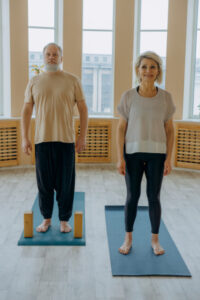*This post may contain affiliate links for which I earn commissions.*
When you’re living with arthritis, it can feel like your body is working against you. The stiffness, the pain—it’s frustrating. But here’s the thing: movement is one of the best things you can do to manage arthritis. I’ve found that with the right exercises, not only can you improve mobility, but you can also reduce pain and feel better overall. So, let’s dive into some practical exercises that are gentle on the joints and easy to incorporate into your routine.
Why Exercise Matters for Arthritis
Regular physical activity offers numerous benefits for arthritis sufferers:
- Reduces joint stiffness by keeping the body moving.
- Strengthens muscles to support and protect joints.
- Improves flexibility, making daily movements easier.
- Aids weight management, reducing strain on joints.
- Boosts mood by increasing endorphin levels.
💡 Tip: Always consult with a healthcare provider before starting a new exercise routine to ensure it meets your needs.
1. Range-of-Motion Exercises (Daily)

Range-of-motion exercises are simple but effective. They help keep your joints flexible and reduce stiffness, which is especially helpful in the morning or after sitting for long periods.
- Shoulder Rolls: Sit or stand upright. Gently roll your shoulders forward, then backward in a circular motion. This helps loosen up the shoulder joints.
- Ankle Circles: While seated, lift one leg and rotate your ankle in a circular motion. This keeps your ankles flexible and can be done anywhere—even while watching TV!
- Neck Stretches: Slowly tilt your head forward, backward, and side to side. This relieves tension in your neck and upper spine.
These exercises can be done daily and don’t require any special equipment. Just go at your own pace and listen to your body.
2. Strengthening Exercises (2-3 Times a Week)

Strengthening the muscles around your joints can really help improve your joint stability and overall strength. Start small and gradually increase the resistance as you get stronger.
- Leg Raises: Lie flat on your back. Lift one leg at a time, keeping it straight, then slowly lower it back down. Repeat on the other side. This strengthens your quadriceps, which support the knee joints.
- Bicep Curls: Grab a light dumbbell or a water bottle in each hand. Slowly curl your arms upward toward your shoulders, then lower them back down. Strengthening your arms can reduce strain on your wrists and elbows.
- Wall Push-Ups: Stand facing a wall. Place your hands shoulder-width apart on the wall and slowly lean in, then push back to your starting position. This is a great low-impact way to work your chest and arm muscles without putting stress on your joints.
Focus on doing these exercises two to three times a week, giving your muscles time to recover in between.
3. Low-Impact Aerobic Exercises (Most Days of the Week)

Low-impact aerobics are fantastic for building endurance without over-stressing your joints. The key here is to find activities you enjoy, so it doesn’t feel like a chore.
- Walking: Walking is one of the simplest exercises and can be easily adapted to your fitness level. Start with short, brisk walks and gradually increase your time. Walking on flat surfaces helps minimize joint strain.
- Cycling: Whether you’re using a stationary bike or cycling outdoors, this is a great way to get your heart pumping without the impact on your knees and hips that running might cause.
- Water Exercises: If you have access to a pool, swimming or water aerobics are perfect. The water supports your body weight, reducing pressure on your joints while still providing resistance to strengthen muscles.
These exercises not only improve your cardiovascular health but also help reduce overall pain and stiffness. Aim for at least 30 minutes of aerobic activity most days of the week, but feel free to break it up into shorter sessions if that works better for you.
4. Flexibility & Mindfulness Exercises (2-3 Times a Week)

Improving flexibility is key to staying mobile and reducing joint stiffness. Flexibility exercises, especially when combined with mindfulness, can be incredibly soothing.
- Yoga: Gentle yoga poses focus on stretching and strengthening your muscles. It’s a fantastic way to improve flexibility while also promoting relaxation. If you’re new to yoga, look for arthritis-friendly or beginner classes.
- Tai Chi: This ancient Chinese practice involves slow, flowing movements that are great for improving balance, flexibility, and coordination. It’s gentle on the joints and has been shown to help with arthritis symptoms.
- Pilates: Pilates emphasizes core strength and flexibility. It can improve your posture and overall body conditioning, which helps relieve joint pain. Look for classes or videos that cater to beginners or those with limited mobility.
Adding flexibility exercises to your routine helps you stay limber and reduces the risk of injury during other activities. Aim to include stretching after your workouts when your muscles are warm.
Tips for Exercising with Arthritis
- Start Slowly: Especially if you’re new to exercise or dealing with a flare-up, take it slow. Gradually increase the duration and intensity of your exercises as you feel more comfortable.
- Listen to Your Body: You know your body best. If something doesn’t feel right or causes discomfort, modify the exercise or try a different one. The goal is to feel better, not to push through pain.
- Use Heat or Cold Therapy: Applying heat before exercise can help loosen up stiff joints, while cold therapy afterward can reduce inflammation and soothe any soreness.
- Get Professional Guidance: If you’re unsure where to start or how to adapt exercises to your needs, consider working with a physical therapist or fitness trainer who specializes in arthritis management. They can create a personalized plan for you.
The Takeaway
Regular exercise is one of the best tools you have for managing arthritis. By incorporating range-of-motion, strengthening, aerobic, and flexibility exercises into your routine, you’ll likely notice improvements in how you feel and move. Remember, it’s all about listening to your body and finding what works best for you.
Related Articles:
🙋♀️ Join the Conversation
Feel free to leave a comment below and share your experiences! What exercises have helped you cope with arthritis? Your tips might just make someone else’s journey a little easier.

